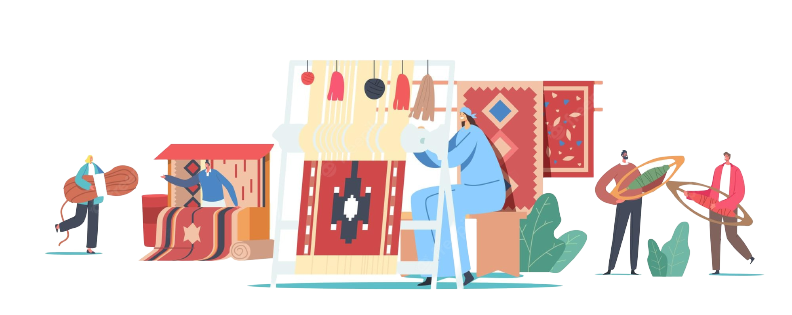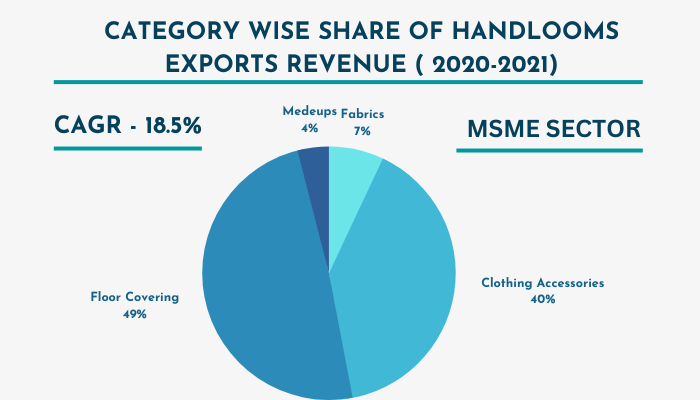Project Report For Handloom Industry
Introduction
Project report on Handloom Industry is as follows.
A loom called a “handloom” is one that weaves fabric devoid of power. Pit looms or frame looms are typically found in weavers’ houses where hand weaving is done. Warp (length) and weft (width) are the two sets of yarn that are most commonly interlaced in weaving (width). The loom is the piece of machinery that makes this interlacing possible.
The Indian handloom industry, one of the biggest and oldest industries in India, has a long history that goes back thousands of years to its remarkable craftsmanship. It is a vibrant representation of Indian culture. Indian artisans were so skilled in fabrics during the Babylonian and Egyptian dynasties. The world admired their traditional hand-spinning, -weaving, and -printing techniques that had been handed down through the years. Nearly 10 million artisans are employed by this industry, one of the largest in the world, in India, which is recognized as the country’s second-largest source of income after agriculture.
In our country, the North East leads the state-by-state distribution and employs 48.98% of the women working in the handloom industry. West Bengal has 13.85%, Tamil Nadu has 5.64%, and Orissa has 1.73%.

In addition to numerous initiatives, the government has a substantial institutional support system for the handloom industry. The National Handloom Development Programe offers marketing help, block-level cluster project support, and concessional loans. The government also has a number of additional initiatives and programs, including yarn supply plans, export advertising, geographic indication of commodities, and the E-Dhaga app.
Sample Project Report On Handloom Industry
Get Completely Custom Bankable Project Report
This sector accounts for around 19% of the nation’s total fabric production, significantly increasing export earnings. The handloom’s exceptional elasticity and flexibility encourage exploration and inventiveness. Utilizing a handloom has the advantage of allowing for the introduction of distinctive designs that the power loom sector is unable to match. Handloom is thus a legacy of India that demonstrates the artistic ability of the weavers as well as the variety and diversity of our country.
Market Potential Of Handloom Industry
The MSME sector in India expanded at a CAGR of 18.5% from 2019 to 2020, with growth visible in the handloom, chemical, food processing, fertilizer, and many other sectors. From Rs 6.8 trillion (US$ 91.66 billion) in FY20 to Rs 9.5 trillion (US$ 128.06 billion) in FY21, loan disbursals to MSMEs grew by 40%.
The primary handloom goods exported from India are mats and mattings, carpets, rugs, bedsheets, cushion covers, and other items. Mats and matting exports from the nation made up about 29% of total exports in 2020–21. Textiles for the home make up more than 60% of India’s handloom exports. The value of carpets, rugs, and mats produced on handlooms for 2020–21 was Rs. 224.4 crores (US$ 28 million), or 13.6% of all exports. At that time, cotton durries exports totaled Rs. 104.53 crores (US$ 13 million). Indian silk scarves are well-liked worldwide. These handwoven goods account for a sizeable portion of all handwoven exports, which are expected to total Rs. 61.5 crore ($7.7 million) in 2020–21. About 23.5% of 2020–21 exports were made up of all handwoven linen items, including cotton bed linen, bathroom linen, kitchen linen, napkins, pillows, cushion covers, tablecloths, and so on.

The “India Handloom” Brand (IHB) was introduced by the Honorable Prime Minister of India on the First Handloom Day, which was observed on August 7, 2015, to promote the quality of the products in terms of the raw materials used, the weaving process, and other factors, in addition to social and environmental compliances. In order to meet the demands of customers looking for specialized handmade goods, the “India Handloom” name will only be awarded to high-quality, authentic handloom products that are free of defects. The “India Handloom” Brand aims to create a distinct market niche and boost weavers’ incomes. The idea behind “India Handloom” is to market handloom goods that meet the “quality” needs of socially and environmentally sensitive consumers.
